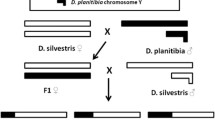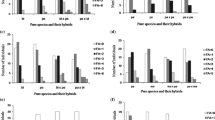Abstract
Our long range interracial hybridization experiments between a pair of cross fertile races, Drosophila nasuta (2n = 8) and D.albomicans (2n = 6) have resulted in the evolution of two new karyotypic strains under laboratory conditions, which are named as Cytorace 1 and Cytorace 2. These Cytoraces harbor chromosomes from both parents. Here, we compare the body size of the parental races and newly evolved Cytoraces and the relationship between the body size and fitness. Analysis reveals that the parental races have reduced fertility and are larger in body size than newly evolved Cytoraces. Thus, the newly evolved Cytoraces show reduced body size and better fitness in the course of their evolution.
Similar content being viewed by others
References
Ashburner, M., 1989. Drosophila: A laboratory manual. Cold Spring Harbor Laboratory Press, Cold Spring Harbor, N.Y.
Bull, J.J., 1987. Evolution of phenotypic variance. Evolution 41(2): 303–315.
Capy, P., E. Pla & J.R. David, 1993. Phenotypic and genetic variability of morphometrical traits in natural populations of Drosophila melanogaster and Drosophila simulans I. Geographic variations. Genet. Sel. Evol. 25: 517–536.
Chakir, M., J.R. David, E. Pla & P. Capy, 1995. Genetic basis of some morphological differences between temperate and equatorial populations of Drosophila melanogaster. Experientia 51: 744–748.
Chang, H., D. Wang & F.J. Ayala, 1989. On the origin of incipient reproductive isolation. The case of Drosophila albomicans and D. nasuta. J. Mol. Evol. 28: 337–348.
Coyne, J.A., J. Rux & J.R. David, 1991. Genetics of morphological differences and hybrid sterility between D. sechellia and its relatives. Genet. Res. 57: 113–122.
David, J.R., 1979. Utilization of morphological traits for the analysis of Genetic variation in wild populations. Aquilo Ser. Zool. 20: 49–61.
David, J.R., B. Moreteau, J.P. Gauthier, G. Petavy, A. Stockel & A.G. Imasheva, 1994. Reaction norms of size characters in relation to growth temperature in Drosophila melanogaster: an isofemale lines analysis. Genet. Sel. Evol. 26: 229–251.
Hagele, K. & H.A. Ranganath, 1982. The chromosomes of two Drosophila races: D. nasuta nasuta and D. n. albomicana. II. Differences in their microchromosomes. Chromosoma 85: 215–220.
Hegde, S.N. & M.S. Krishna, 1997 Size-assortative mating in Drosophila malerkotliana. Anim. Behav. 54: 419–426.
Leibowitz, A.M., Santos & A. Fontdevila, 1995. Heritability and selection on body size in a natural population of Drosophila buzzatii. Genetics. 141: 181–189.
Moreteau, B., P. Capy, A. Alonso-Moraga, A. Munoz-Serrano, J. Stockel & J.R. David, 1995. Genetic characterization of geographic populations using morphometrical traits in Drosophila melanogaster: isogroups versus isofemale lines. Genetica. 96: 207–215.
Morin, J.P., B. Moreteau, G. Petavy, A.G. Imasheva & J.R. David, 1996. Body size and developmental temperature in Drosophila simulans: Comparison of reaction norms with sympatric Drosophila melanogaster. Genet. Sel. Evol. 28: 415–436.
Nirmala, S.S., 1973. Cytogenetic studies on the Drosophilids of Mysore State. PhD Thesis, University of Mysore, Mysore.
Prout, T., 1971. The relation between fitness components and population prediction in Drosophila. 1. The estimation of fitness components. Genetics 68: 127–149.
Ramachandra, N.B., 1987. Contributions to population cytogenetics of Drosophila: Studies on interracial hybridization and B-chromosomes, PhD Thesis, University of Mysore, Mysore.
Ramachandra, N.B. & H.A. Ranganath, 1986. The chromosomes of two Drosophila races: D. nasuta nasuta and D. nasuta albomicana IV. Hybridization and karyotype repatterning. Chromosoma 93: 243–248.
Ramachandra, N.B. & H.A. Ranganath, 1987. Mating preference between Drosophila nasuta nasuta and D. n. albomicana. Indian J. Exp. Biol., 25: 55–57.
Ramachandra, N.B. & H.A. Ranganath, 1994. Pattern of sexual isolation between parental races (Drosophila nasuta nasuta and D. n. albomicans) and the newly evolved races (Cytoraces I & II). Indian J. Exp. Biol. 32: 98–102.
Ramachandra, N.B. & H.A. Ranganath, 1995–96. Population differentiation: A study with two strains of Drosophila albomicans. J. Mysore University, sec. B 34: 12–27.
Ramachandra. N.B. & H.A. Ranganath, 1996. Evolution of nasutaalbomicans complex of Drosophila. Curr. Sci. 71(7): 515–517.
Ranganath. H.A. 1975. Genetic integrity, population density and selection studies in a few members of the immigrans group of Drosophila, PhD thesis, University of Mysore, Mysore.
Ranganath, H.A. & K. Hagele, 1981. Karyotypic orthoselection in Drosophila. Naturwissenchaften 68: 527–528.
Ranganath, H.A. & K. Hagele, 1982. The chromosomes of two Drosophila races: D. nasuta nasuta and D. nasuta albomicana I. Distribution and differentiation of heterochromatin. Chromosoma 85: 83–92.
Ranganath, H.A. & N.B. Ramachandra, 1987. Chromosomal basis of raciation in Drosophila: A study with Drosophila nasuta and D. albomicana. Proc. Indian Acad. Sci (Anim sci) 96: 451–459.
Ranganath, H.A. & N.B. Ramachandra, 1994. Drosophila albomicans — A unique karyotype. The Nucleus 37(3): 105–112.
Robertson, F.W., 1987. Variation of body size within and between wild populations of Drosophila buzzatii. Genetica 72: 111–125.
Roff, D.A., 1986. Predicting body size with life history models. Bioscience 36: 316–323.
Ruiz, A.M., A. Santos, J.E. Barbadilla, E. Quezada-Diaz, Hassan & A. Fontdevila, 1991. The evolutionary history of Drosophila buzzatii XVIII. Genetic variation for body size in a natural population. Genetics 128: 739–750.
Santos, M., A. Ruiz, J.E. Quezada-Diaz, A. Barbadilla & A. Fontdevila, 1992. The evolutionary history of Drosophila buzzatii XX. Positive phenotypic covariance between field adult fitness components and body size. J. Evol. Biol. 5: 403–422.
Singh, B.N. & S. Mathew, 1997. Greater fertility of Drosophila ananassae flies possessing high number of sternopleural bristles. Curr. Sci. 72: 112–114.
Sokoloff, A., 1966. Morphological variation in natural and experimental populations of Drosophila pseudobscura and Drosophila persimilis. Evolution 20: 49–71.
Wilson, F.D., M.R. Wheeler, M. Harget & M. Kambysellis, 1969. Cytogenetic relations in the Drosophila nasuta subgroup of species. Univ. Texas Publ. 6918: 207–254.
Author information
Authors and Affiliations
Rights and permissions
About this article
Cite this article
Harini, B., Ramachandra, N. Does evolution reduce the body size? A study of the four members of newly evolved nasuta‐albomicans complex of Drosophila. Genetica 105, 1–6 (1999). https://doi.org/10.1023/A:1003762826116
Issue Date:
DOI: https://doi.org/10.1023/A:1003762826116




